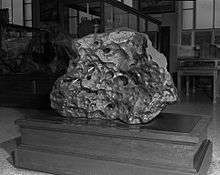Goose Lake meteorite
| Goose Lake meteorite | |
|---|---|
 Goose Lake meteorite on display | |
| Type | Iron meteorite |
| Group | IAB-sLL |
| Country | United States |
| Coordinates | 41°58′48″N 120°32′30″W / 41.98000°N 120.54167°WCoordinates: 41°58′48″N 120°32′30″W / 41.98000°N 120.54167°W |
| Observed fall | No |
| Found date | 1938-10-13 |
| TKW | 1,170 kilograms (2,580 lb) |
|
| |
The Goose Lake meteorite is a meteorite that was found at Goose Lake in the United States by two hunters from Oakland, California on October 13, 1938.
In 1939 it was acquired by the United States National Museum. From 1939 until January 14, 1941 it was on exhibition at the Golden Gate International Exposition before moving to Washington, D.C.. It was placed on display in the National Museum's meteorite hall until that hall was closed in the 1950s. Today, the meteorite is on display at the National Museum of Natural History.[1]
No crater was left on the ground where it was found, thus meaning that the velocity of the meteorite's impact was minimal.[2]
See also
References
- ↑ "Goose Lake Meteorite on Exhibit". 41402. Smithsonian Institution Archives. Retrieved 26 May 2012.
- ↑ Cook, C. Sharp; Butler, C. P. (May 15, 1965). "Origin of the Goose Lake Meteorite". Nature. 206: 704–705. Bibcode:1965Natur.206..704C. doi:10.1038/206704a0. Retrieved 26 May 2012.
This article is issued from
Wikipedia.
The text is licensed under Creative Commons - Attribution - Sharealike.
Additional terms may apply for the media files.